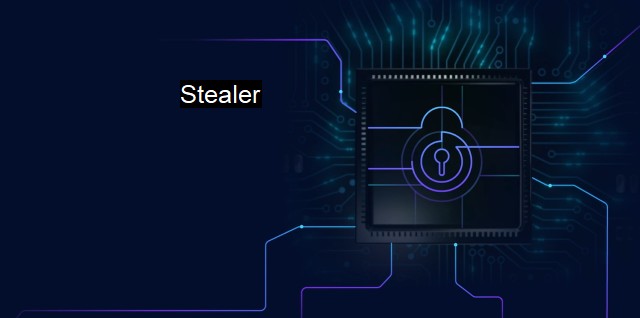What is Stealer?
Understanding Stealer: The Dangerous Malware Used for Stealing Personal Information and Financial Data
The term "Stealer" within the context of cybersecurity denotes a type of malicious software that cybercriminals use to illicitly obtain or "steal" sensitive and personal information stored on victims' computer systems. It mostly targets data that can be leveraged financially, such as credit card information, online banking credentials, cryptocurrency wallets, personal identification data, social security numbers, and passwords.Stealers are typically embedded in a system through Trojan horses or other hacktivist-initiated cyberattacks, breaching security systems with the sole intent to gather, transmit and sell personal data. Their operations are stealthy, invisible to the naked eye, and unnoticeable in the system's performance, making them exceptionally effective infiltrators.
The manifestation of stealers as password-stealing worms or keyloggers has been noted, targeting stored passwords in browsers or capturing keystrokes, a tactic that captures exhaustive species of passwords and other delicate information. They have impregnated an array of systems such as Point-of-Sale (POS) systems, ATM operating systems and even databases with colossal personal records such as healthcare and government records.
A stealer virus should indeed be a key concern in today's internet-driven world. Businesses, financial institutions, government agencies, and consumers have reported billions of dollars in losses owing to their activities. Many individuals also have had their identities stolen, with the procured information serving as a base for fraudulent actions such as opening unauthorized accounts, making purchases, or even brokering the information on the dark web.
Preventing, identifying, or eradicating a stealer varies in complexity but relies majorly on an antivirus or cybersecurity suite or a deeply managed security service for organizations. It is advisable to employ robust and up-to-date antivirus software recognized for catching different variants of stealers. Many software is designed to detect abnormalities or potential threats and notify the user, giving a fighting chance to respond and shield personal data swiftly.
Regular software updates are cardinal, along with an overhaul of firewall configurations, intrusion detection systems (IDS), and security information and event management (SIEM) features—all fitting into a comprehensive security plan that fortifies an organization's system.
By precautionary principle, it is also essential to endorse safe internet practices. Regularly updating passwords, enabling two-factor authentication, avoiding visiting unsecured websites, and desisting from downloading suspicious email attachments can place a robust defensive mechanism against potential cyber threats.
Stealing methods and vectors have advanced with technology. The proliferation of Internet of Things (IoT) devices, cloud storage technologies, and smartphones intertwine with personal and professional life, expanding the perimeter for stealer attacks. It has led to threatening developments of stealers for mobile banking apps and cloud storage repositories—a direct repercussion of transiting essential services to an increasingly digital platform.
For businesses, implementing non-negotiable cybersecurity regulations becomes a necessity more than ever due to such technological advancements. This may involve digital literacy and education on recognizing potential threats such as phishing, employing a continuous and regular backup regime of all critical data and systems, costly as it may be.
To stem the tide of stealers, retaliation via both a stronger static defense (antivirus applications, encryption, secure servers, and more) and dynamic responses—like multi-layer authentication processes and user education—becomes crucial.
“stealer’’ is a herculean concern for the cybersecurity industry, not due to its technological sophistication but because of its unique materials of embodiment, undetectability, damage potential, and speed of transformation. These stealthy assailants necessitate the continuous armor of personal data, recognize evolving threats, and wisely invest in robust security measures.

Stealer FAQs
What is a stealer in the context of cybersecurity?
A stealer is a type of malware that is designed to steal sensitive information from a victim's computer. It can steal passwords, credit card numbers, and other personal information. Stealers are often used by cybercriminals to gain access to a victim's accounts or to commit identity theft.How does a stealer work?
A stealer works by infecting a victim's computer with malware. Once installed, the malware can monitor the victim's activities and capture the sensitive information that is entered into the computer. The information is then sent back to the attacker, who can use it to gain access to the victim's accounts or to commit fraud.What can I do to protect myself from stealers?
To protect yourself from stealers, it's important to keep your computer and antivirus software up to date. You should also be careful when downloading files or clicking on links from unknown sources. Additionally, you should avoid using the same password for multiple accounts, and consider using two-factor authentication for added security.How can I remove a stealer from my computer?
Removing a stealer from your computer can be difficult, as it is designed to evade detection. Your best course of action is to use a reputable antivirus program to scan your computer and remove any malware that is detected. It's also a good idea to change any passwords that may have been compromised by the stealer.| | A | | | B | | | C | | | D | | | E | | | F | | | G | | | H | | | I | | | J | | | K | | | L | | | M | |
| | N | | | O | | | P | | | Q | | | R | | | S | | | T | | | U | | | V | | | W | | | X | | | Y | | | Z | |
| | 1 | | | 2 | | | 3 | | | 4 | | | 7 | | | 8 | | |||||||